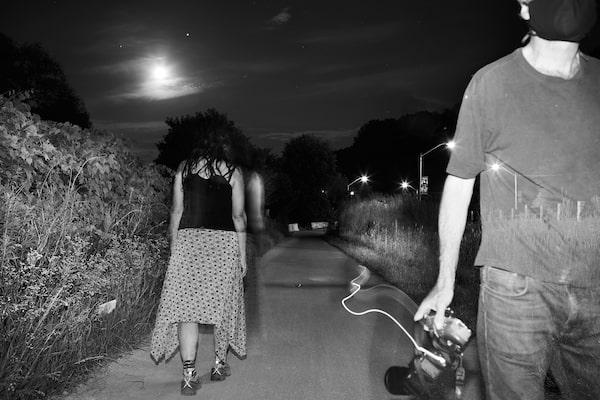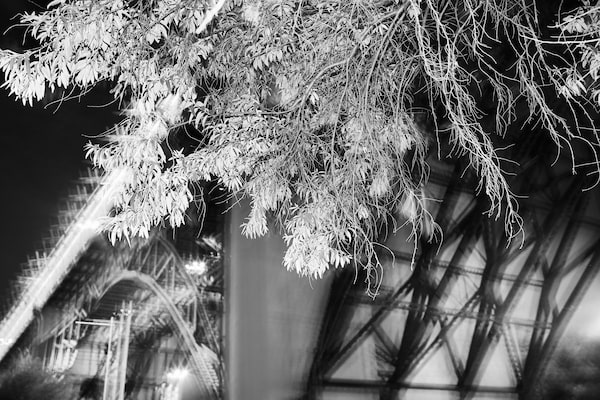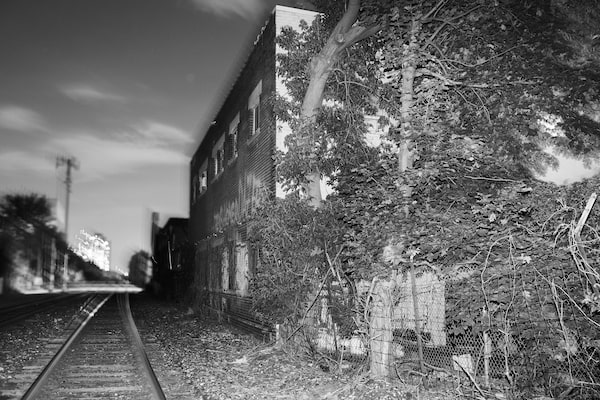
“You really should be photographing this,” said my close friend and neighbour Don McKellar, at the onset of the pandemic. I’ve spent my career documenting communities and for me, photography is about engaging in the relationships between people and the worlds they inhabit. “But what can I take photographs of? I’m a people photographer,” I replied. “And they’re saying we can’t see anyone or go anywhere. We can’t even leave Toronto. I’m not going to go out alone and photograph the deserted city.” Then, without missing a beat, he says, “I’ll be your subject.” Now that got my interest.
By day, the streets had become challenging to safely navigate on foot, despite wearing masks. I’d tried running to let off steam, but I ended up swinging around cars and dodging traffic to respect a two-metre distance from anyone on the sidewalk. Eventually, I was only leaving my house past midnight.
The next day, I texted Don: “Ok, I have an idea, but you’re going to be shooting too.” I knew Don would get bored if he didn’t have more agency in the game. Our first night out, we were uncertain and cautious. We knew nothing then about this new threat. Was it suspended in the air? Are we even supposed to be out at all? Was photography “essential work?” I handed Don a camera and a flash. “Okay, let’s go!”
And this is how it began, like all photography projects, starting with one photograph, and then another, not knowing what it would become, but with a commitment to see what we could discover about ourselves and our city in these unprecedented circumstances. As our reciprocal subject-photographer collaboration evolved, we became each other’s mirror muses, transforming into something other than ourselves in front of each other’s cameras.

Time went by, measured in infection rates and death tolls. The first wave was followed by a second, then a third. The seasons, one of the few things we could truly count on, brought welcome changes: rain, heat, below freezing temperatures, blinding snow, rain again. We photographed through it all and crossed locations off the list we made of Toronto landmarks: the Port of Toronto, the Gardiner Expressway, the railway tracks on Dupont, the Bloor Street Viaduct, St. James’ Cemetery, underneath the Don Valley Parkway, the Humber Bay Arch River Bridge, Ontario Place, Canoe Landing Park, and Trinity Bellwoods Park, with its eerie “physical distance circles” …
At night, under the influence of our flash, long exposures, and other photographic techniques, Toronto took on a dream-like, apocalyptic cast: unpeopled iconic streetscapes and building-scapes, the city’s many green spaces, parks and ravines, nature juxtaposed against the built environment, both in conjunction with one another. We are the only two people left. The only souls we encountered were the birds of Toronto Island and passers-by living in the streets, in parks, under bridges. “Hey, buddy, got a cigarette?” “Want to take a picture of my [paintball] gun?”
One night at the Scarborough Bluffs around 3 a.m., as we were leaving, walking up a winding pathway, we hid in the trees when we heard gun shots, followed by revving sounds and cars barreling out of the parking lot below, as the lights and sirens of police cruisers headed toward us from the other direction at high speed down Brimley Road. All I could think was thank goodness – a tiny surge of adrenaline, a break in the boredom and monotony of half a year under lockdown.

Meanwhile, there were murmurings about introducing a nighttime curfew in Toronto. Selfishly, we thought, “Oh no! Anything but a curfew! Anything! Please don’t deny us our photographic night wanderings with our cameras!” It was our connection – the very fabric of our pandemic lives could be at stake. Months before June of last year, when the chief medical officer announced a public-health advisory endorsing social circles that allowed individuals to “bubble” outside their households, Don and I had already stretched the rules, started our project and were having dinners together. Many single people were facing an appalling, unknowable timeline alone, without companionship or physical contact with another human being. There is something frustratingly paradoxical and cruel about being confined in a city together, unable to leave, but forbidden to commune.
The city at night during the most anti-social hours was our stage and our playground. The pandemic dictated the rules of engagement: two metres apart, wearing masks, after dark. The camera is intrinsically a mechanism that relies on distance. Marshall McLuhan said that all technologies are extensions of man. The camera is an extension of the eye and of the finger (and of the heart and of feelings). Our twin set-ups included a fixed focal length prime lens: 35 mm. We used flash and a tripod – the latter so we could establish third person point of view for some of the shots, with both of us appearing, appropriately physically distanced, in the same frame. We shot in black and white, which in photography pushes the metaphor of unreality, one more remove from the familiar, evoking the way in which Toronto, a city we’d both grown up in and thought we knew, had become strange and unfamiliar. Gone were the activities and sights and sounds of everything that used to define this place. We became childlike, exploring the city anew, regressing from civilization as the natural world encroached increasingly into our nocturnal explorations. Our perception of time was altered, disorienting, confusing. Uncertainty, fear, anxiety, loneliness and loss surrounded us. Photography was a salve for our isolation, bringing intimacy into the emptiness.

The fourth wave arrived without ceremony during the dog days of summer this year, like bad news you have come to expect. But vaccines brought new hope and life into the city. And while we knew things would never go back to how they were before, everything was changing and all we had been through that year was slipping away like an ungraspable dream.
On our last shoot of the last season of the First Pandemic Year, we climbed the fence at the Toronto Necropolis in Cabbagetown to take photographs of the blossom trees, those symbols of possibility and renewal. We set up our tripod and lights and framed the shot for a close-up. Standing two metres apart, we each reached a hand toward the other, extending our fingers across the flowering branches of an apple tree, and let the shutter release itself on a timer. And that’s where we left “our two friends” (as we had taken to calling our alter egos) – in a stalemate of perpetual reaching, forever un-touching across time and space, frozen in a photograph, an infinite distance between them.
-Rita Leistner
Rita Leistner is a photographer, writer and filmmaker. Her new book Forest for the Trees: The Tree Planters launches at the Stephen Bulger Gallery in Toronto on Oct. 23 and the related film has its international premiere in November.
Don McKellar is an actor, writer and filmmaker based in Toronto.
Infinite Distance is presented by the Stephen Bulger Gallery, and will be featured in its exhibition Wanderlust, Jan. 29 to Feb. 26, 2022.